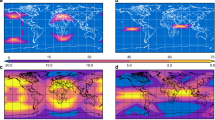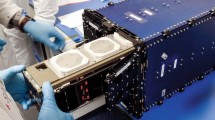Abstract
The development of small satellites for telecommunication constellations in low-Earth orbit provides a unique opportunity to the astronomical community. Mass-produced, commercial satellite platforms can host dedicated scientific payloads and expand access to space-based astronomy. Technologies critical to the development of small orbital instruments have been demonstrated by exploratory missions. By employing these capabilities and techniques in mass-produced spacecraft, terrestrial limitations such as geography, atmosphere and planetary motion can be overcome at a fraction of the cost of traditional space-based astronomy missions. Instruments could be deployed across swarms, or even constellations, of small, cheap and reliably produced spacecraft. With the continuing democratization of space, it is now timely and opportune to consider the approaches necessary to maximize the scientific potential of innovations driven by the commercial sector.
This is a preview of subscription content, access via your institution
Access options
Access Nature and 54 other Nature Portfolio journals
Get Nature+, our best-value online-access subscription
$29.99 / 30 days
cancel any time
Subscribe to this journal
Receive 12 digital issues and online access to articles
$119.00 per year
only $9.92 per issue
Buy this article
- Purchase on Springer Link
- Instant access to full article PDF
Prices may be subject to local taxes which are calculated during checkout
Similar content being viewed by others
References
Parham, J. B. et al. Leveraging commercial cubesat constellations for auroral science: a case study. J. Geophys. Res. Space Phys. 124, 3487–3500 (2019).
Millan, R. M. et al. Small satellites for space science: a COSPAR scientific roadmap. Adv. Space Res. 64, 1466–1517 (2019).
Leverington, D. New Cosmic Horizons: Space Astronomy from the V2 to the Hubble Space Telescope (Cambridge Univ. Press, 2000).
Rajan, R. T. et al. Space-based aperture array for ultra-long wavelength radio astronomy. Exp. Astron. 41, 271–306 (2015).
Smith, H. J. in Low Frequency Astrophysics from Space (eds Kassim, N. E. & Weiler, K. W.) 29–33 (Springer, 1990).
Bentum, M., Verhoeven, C. & Boonstra, A.-J. In Proc. 20th Annual Workshop on Circuits, Systems and Signal Processing, ProRISC 2009 26–27 (Technology Foundation, 2009).
Klein-Wolt, M. et al. A White Paper for a Low-frequency Radio Interferometer Mission to Explore the Cosmological Dark Ages for the L2, L3 ESA Cosmic Vision Program (2013); https://go.nature.com/3ckayoh
Saks, N. et al. In Small Satellite Systems and Services – The 4S Symposium 1–15 (ESA, CNES, 2010).
Fish, V. L., Shea, M. & Akiyama, K. Imaging black holes and jets with a VLBI array including multiple space-based telescopes. Adv. Space Res. 65, 821–830 (2020).
Kramer, H. J. & Cracknell, A. P. An overview of small satellites in remote sensing. Int. J. Remote Sens. 29, 4285–4337 (2008).
Ballhaus, W. F. Jr et al. James Webb Space Telescope (JWST) Independent Comprehensive Review Panel (ICRP): Final Report (NASA, 2010); https://go.nature.com/2HkZ2hh
Spitzer, L. Jr Report to project rand: astronomical advantages of an extra-terrestrial observatory. Astron. Q. 7, 131–142 (1990).
Billings, L. The telescope that ate astronomy. Nature 467, 1028–1030 (2010).
Witze, A. Delays mount for NASA’s $8-billion Hubble successor. Nature 559, 16–18 (2018).
Weiler, K. W. in Low Frequency Astrophysics from Space (eds Kassim, N. E. & Weiler, K. W.) 8–18 (Springer, 1990).
Di Mauro, G., Lawn, M. & Bevilacqua, R. Survey on guidance navigation and control requirements for spacecraft formation-flying missions. J. Guid. Control. Dyn. 41, 581–602 (2018).
Sweeting, M. Modern small satellites – changing the economics of space. Proc. IEEE 106, 343–361 (2018).
Bandyopadhyay, S. et al. In Proc. 53rd AIAA Aerospace Sciences Meeting https://doi.org/10.2514/6.2015-1623 (AIAA, 2015).
Baade, D. In 3rd BRITE Science Conference (eds Wade, G. A. et al.) 15–20 (PTA, 2018).
Bentum, M. J., Verhoeven, C. J. M., Boonstra, A. J., van Der Veen, A. J. & Gill, E. K. A. In Proc. 60th Internation Astronautical Congress 1254–1261 (IAC, 2009).
Cahoy, K. CubeSats in Astronomy and Astrophysics (MIT, 2015); https://go.nature.com/3chUlQu
Deschamps, N. C. et al. The BRITE space telescope: using a nanosatellite constellation to measure stellar variability in the most luminous stars. Acta Astronaut. 65, 643–650 (2009).
Knapp, M. et al. Demonstrating high-precision photometry with a CubeSat: ASTERIA observations of 55 Cancri e. Astron. J. 160, 23 (2020).
Alexander, K. D. et al. The electromagnetic counterpart of the binary neutron star merger LIGO/Virgo GW170817. VI. Radio constraints on a relativistic jet and predictions for late-time emission from the kilonova ejecta. Astrophys. J. Lett. 848, L21 (2017).
Lipunov, V. M. et al. MASTER optical detection of the first LIGO/Virgo neutron star binary merger GW170817. Astrophys. J. Lett. 850, L1 (2017).
Reiner, M. J., Fainberg, J., Kaiser, M. L. & Stone, R. G. Type III radio source located by Ulysses/Wind triangulation. J. Geophys. Res. Sp. Phys. 103, 1923–1931 (1998).
Obrocka, M., Stappers, B. & Wilkinson, P. Localising fast radio bursts and other transients using interferometric arrays. Astron. Astrophys. 579, 69 (2015).
Maley, P. D. & Pizzicaroli, J. C. The visual appearance of the Iridium satellites. Acta Astronaut. 52, 629–639 (2003).
Hainaut, O. R. & Williams, A. P. Impact of satellite constellations on astronomical observations with ESO telescopes in the visible and infrared domains. Astron. Astrophys. 636, A121 (2020).
Gallozzi, S., Scardia, M. & Maris, M. Concerns about ground based astronomical observations: a step to safeguard the astronomical sky. Preprint at https://arxiv.org/abs/2001.10952v2 (2020).
Kirchner, S. The Impact of Large-scale Satellite Constellations on Earth-based Astronomy as a Problem of International Law (SSRN, 2020); https://doi.org/10.2139/ssrn.3518056
Venkatesan, A., Lowenthal, J., Prem, P. & Vidaurri, M. The impact of satellite constellations on space as an ancestral global commons. Nat. Astron. https://doi.org/10.1038/s41550-020-01238-3 (2020).
Djorgovski, S. G. In Proc. Seventh International Workshop on Computer Architecture for Machine Perception (CAMP’05) 125–132 (IEEE, 2005).
Szalay, A. & Gray, J. The world-wide telescope. Science 293, 2037–2040 (2001).
Faerber, N. et al. In Proc. SpaceOps 2016 Conference https://doi.org/10.2514/6.2016-2595 (AIAA, 2016).
Lin, Z., Li, W., Jin, J., Yan, J. & Kuang, L. In Space Information Networks (ed. Yu, Q.) 207–220 (Springer, 2019).
Palmintier, B., Kitts, C., Stang, P. & Swartwout, M. In Proc. 16th Annual AIAA/USU Conference on Small Satellites 6–9 (AIAA, 2002).
Shao, M. & Colavita, M. M. Long-baseline optical and infrared stellar interferometry. Annu. Rev. Astron. Astrophys. 30, 457–498 (1992).
Monnier, J. D. Optical interferometry in astronomy. Rep. Prog. Phys. 66, 789–857 (2003).
Acknowledgements
We gratefully acknowledge the invaluable assistance, advice and critical feedback provided by R. E. Simmonds in preparing this manuscript.
Author information
Authors and Affiliations
Contributions
P.A. carried out the research, writing and editing of the manuscript. J.W.E. compiled the open issues draft analysis. Project planning and commercial information was sourced by M.T.
Corresponding author
Ethics declarations
Competing interests
The authors declare the following competing interests: P.A., J.W.E. and M.T. are paid employees of Airbus Defence and Space Ltd, part of the Airbus Group which owns shares in the joint venture OneWeb Satellites, the manufacturer of the ArrOW platform.
Additional information
Peer review information Nature Astronomy thanks Nigel Bannister and Bruce Yost for their contribution to the peer review of this work.
Publisher’s note Springer Nature remains neutral with regard to jurisdictional claims in published maps and institutional affiliations.
Rights and permissions
About this article
Cite this article
Allen, P., Wickham-Eade, J. & Trichas, M. The potential of small satellites for scientific and astronomical discovery. Nat Astron 4, 1039–1042 (2020). https://doi.org/10.1038/s41550-020-01227-6
Received:
Accepted:
Published:
Issue Date:
DOI: https://doi.org/10.1038/s41550-020-01227-6



